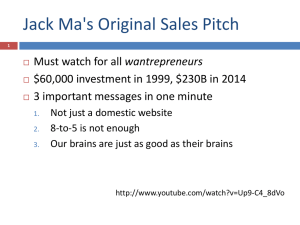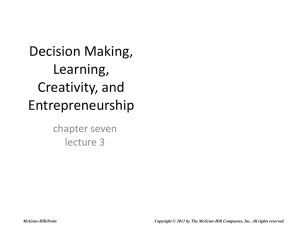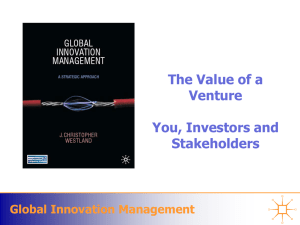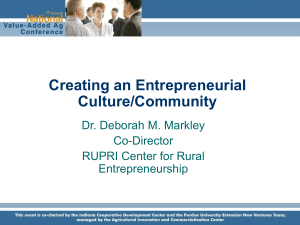Entrepreneurship - PowerPoint Presentation
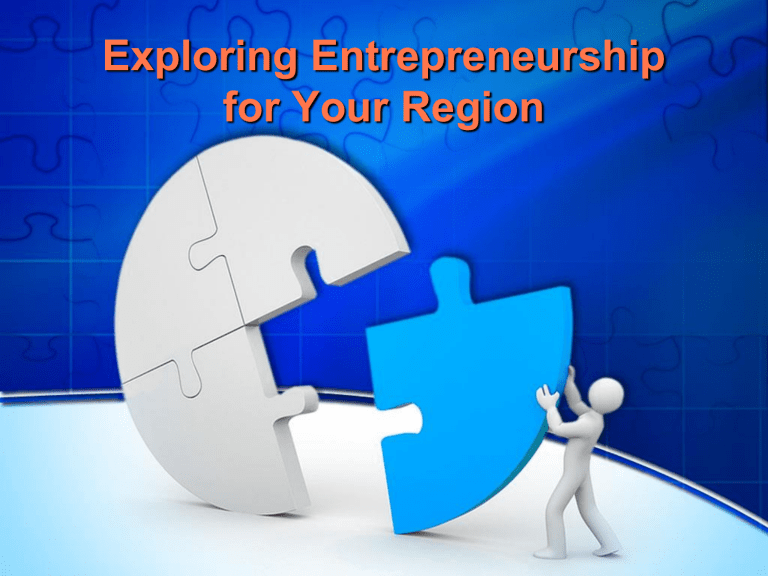
Exploring Entrepreneurship for Your Region
Reflecting on the Previous Sessions
What characteristics of the region led to your interest in cultivating entrepreneurship as an economic development strategy?
What regional clusters do you hope to advance with entrepreneurship development?
Goal for this Session
Explore the tools and resources necessary to develop an action plan to enhance regional entrepreneurship development
Entrepreneurship should not be the economic development strategy of last resort.
The Three-Legged Stool
A Few Definitions
Entrepreneur:
Person whose goal is to create or capitalize on new economic opportunities through innovation
Entrepreneurship:
Process through which entrepreneurs create and grow enterprises
Entrepreneurial Community:
Community where significant economic and social entrepreneurial activity exists within an effective system of public and private support
Entrepreneurship Development:
Policies and practices (public and private) that foster entrepreneurship
Source: Based on Dabson and Wilcox (2012)
Identifying Entrepreneurs
People with underused talent
Social entrepreneurs
Small businesses
Unemployed
Youth
Entrepreneurship
High-growth businesses
Innovators
Self- employed
Collective Visioning
• What might be possible in your region related to entrepreneurship?
• What can build on past or current accomplishments within the region?
Key Questions
Recruit from outside or grow locally?
Serve local needs or export?
Fast growing or slow and steady?
Assessing Regional Capacity
• Community surveys:
Inventory existing programs
Gauge community readiness
Weigh leadership support
Identify existing business networks
Inventory existing businesses
• Interviews with local entrepreneurs:
Assess ambitions and needs
Identify regional barriers
Challenges with Finding Data
• Navigating complex databases
• Using consistent definitions of
“entrepreneur”
• Comparing data across sources
• Geography
Measuring Current Entrepreneurship
• Regional Economic Accounts
(Bureau of Economic Analysis)
• Non-employer Statistics
(Census)
• County Business Patterns
(Census)
• Survey of Business Owners
(Census)
• Panel Study on Entrepreneurial Dynamics
Cultivating New Entrepreneurs
• Educational attainment
• Immigration and diversity
• Financial resources
• Business resources
An Example from Tennessee
Establishing a Regional Goal
• Where we are: Do gaps or unmet needs exist in self-employed/small businesses in our region?
• Where we are going: What do we hope to accomplish for our region?
Entrepreneur & Small
Business Development
Networks,
Mentoring and
Coaching
Supportive
Environment
Training &
Technical
Assistance
Components of Success
Access to Capital
Youth
Entrepreneurship
Access to Capital
• Investment is a “given” for success
• Different sources fit different needs
• Regional approach may have new opportunities
Supportive Environment
• Human, financial, and physical infrastructure
• Supportive climate that engages and celebrates entrepreneurs
• Positive citizen and community attitudes
• Open and creative community leadership that encourages and nurtures emerging leaders
Source: Markley et al (2005)
How Nurturing is Your Region?
Three Phases of Innovation
Conception Implementation Marketing
Business
Process
Regional
Capacity
• Idea generation
• Project planning
• Education
• Technical assistance
• Development
• Prototype creation
• Testing
• R&D centers
• Universities
• Industrial parks
• Production
• Launch
• Capital availability
• Community support
Source : Tawari, Buse and Herstatt, 2007
Entrepreneur Networks
Informal gatherings of entrepreneurs to share experiences and information
• Facilitate, but don’t lead
• Networks should be “by and for” entrepreneurs
20
Mentoring and Coaching
Connecting entrepreneurs with the right people at the right time
Training & Technical Assistance
National
• eXtension Community of Practice
• Small Business Administration
• Small Business Development Centers
State/Local
• State/Local Economic Development Agencies
• Business Incubators/Accelerators
• Microbusiness Development Organizations
University
• Small Business Colleges
• ‘Cashing in on Business’
Youth Entrepreneurship
• Why it is important?
– Filling the pipeline with potential businesses
– Creating a culture that values selfemployment
– Fostering innovation
• What can be done?
– In-school programs
– After-school programs
– 4-H, Girl Scouts/Boy Scouts, etc.
Programs, Models, Resources
• Economic Gardening
• Innovation Centers
• Incubators
• Networks/Clubs
• Entrepreneurial League
System http://www.youtube.com/watch?v=CysIVyskQZI&feature=related
Balancing Available Assets
Asset mapping can help you identify under utilized assets within your region
Equally important is identifying those assets which may be at or over capacity
Region’s Success Components
Component of Success
Access to
Capital
People Volunteer
Associations
Institutions Physical
Resources
Barriers
Environment
Networks,
Mentors,
Coaches
Training &
Technical
Assistance
Youth
Your Region’s Capacity for Innovation
• What are your region’s most competitive assets?
• What assets can help launch new ideas and innovations?
• What resources does your region offer to foster innovation?
Audience Matters!
• Who are your target entrepreneurs?
• What do they need from you?
• Which resources will be most valuable to your region?
Drafting Your
Regional Action Plan
“Good plans shape good decisions.
That's why good planning helps to make elusive dreams come true.”
Lester Robert Bittel
Summary
• Success in economic development strategies does not happen overnight
• Other communities are having success
• Success requires time and energy from the entire region

